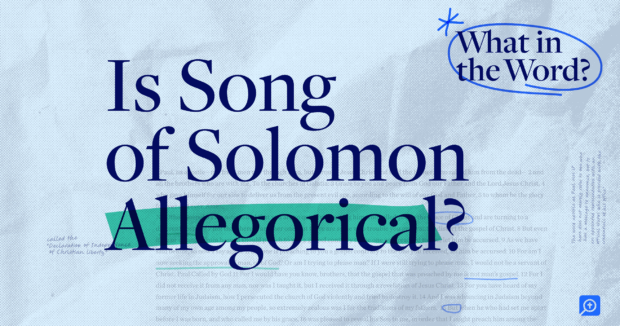What’s the Music of Solomon actually about? Is the Music a literal love poem, an allegory of God’s love, or one thing in between?
On this episode of What in the Word?, Kirk E. Miller is joined by Fellipe do Vale to discover the interpretive challenges of one of many Bible’s harder books. They look at the Music of Music’s character dynamics, imagery, and theological goal as knowledge literature.
Uncover how the Music contributes to a biblical imaginative and prescient of affection and redemption.
Observe the present on YouTube, Spotify, Apple Podcasts, and extra.
Particular affords


A Free E-book Only for You
Logos has given away over 5 million free books, empowering Christians globally to check deeply. Get a shiny, new free e book each month!


Unique Lexham Press Robust Texts Bundle
Have extra questions in regards to the Bible? Get the 10-volume Lexham Press Robust Texts Bundle designed completely for followers of What within the Phrase?
Join with us
Prepared to extend biblical literacy? Like and share. To go the additional mile, depart us a evaluate in your most well-liked platform.
Subscribe to get future episodes. (Bonus: We’ll ship you a reduction to make use of in your first buy.)
Thanks for subscribing to Phrase by Phrase!
Use code WORDBYWORD to avoid wasting 10% in your first order.
WORDBYWORD
Copy code
Episode visitor: Fellipe do Vale
Fellipe do Vale is tutor in doctrine at Trinity Faculty, in Bristol, England. His analysis is totally on the connection between ethical theology and theological anthropology. He focuses on gender, but in addition writes and teaches on political theology, theology of race, and different points of human id, particularly from an eschatological perspective.
He’s the writer of Gender as Love: A Theological Account of Human Identity, Embodied Desire, and Our Social Worlds, together with articles within the Worldwide Journal of Systematic Theology, Professional Ecclesia, and others.
He’s additionally the winner of the 2023 Rising Public Mental award, given by Redeemer College.
Episode synopsis
A curious e book: What’s the Music of Songs?
Kirk E. Miller welcomes Fellipe do Vale to discover one among Scripture’s extra enigmatic books—the Song of Songs (or Song of Solomon). Is that this poetic e book a romantic reflection on human love or an allegory of divine affection between God and his folks?
Kirk and Fellipe’s dialog begins with an outline of the Music, establishing its poetic and theological character, and shortly dives into the interpretive complexities that make the e book so hotly debated and richly rewarding.
The superlative track: what the title tells us
The e book’s title—Music of Songs—instantly suggests its prominence. Just like the biblical phrases “king of kings” or “holy of holies,” this superlative idiom indicators one thing final or unparalleled. It’s not merely a track—it’s the track, suggesting each excellence and significance.
And it’s additionally “of Solomon”—although the that means of this phrase is debated. Is Solomon the writer? A personality? Merely a symbolic reference to royal knowledge? Some translations render this phrase as Solomon’s Music, whereas others counsel it’s a track written “for” or “regarding” Solomon. This ambiguity opens the door to additional interpretive layers, particularly when paired with the dearth of specific historic or narrative framing inside the textual content.


The preposition לְ prefixing the noun “Solomon” (שְׁלֹמֹה) leaves ambiguity.
Deciphering the Music’s poetry: style, context & allusions
Fellipe notes that the Music is troublesome to interpret exactly as a result of it avoids clear, easy discourse. In contrast to letters or histories, poetry works by evocative imagery, oblique allusions, and emotional tone slightly than clear theological propositions.
The textual content affords little or no when it comes to historic setting. Mentions of Solomon, allusions to the temple and Eden, and echoes of different biblical texts are scattered all through, however the e book doesn’t place itself firmly in time. Moderately than being outlined by an apparent plot (like a story), the Music unfolds in poetic vignettes, formed by repetition, longing, and shifting voices.
Furthermore, God is rarely talked about within the e book—a rarity it shares solely with Esther. But, as we’ll see, the absence of such specific theological references doesn’t essentially imply the absence of theological depth.
Who’re the Music’s characters?
Even amongst those that learn the Music as human love poetry, debate continues.
The songs characters embrace a male lover, a feminine beloved, and a refrain or group of onlookers. However interpretations fluctuate of their identification of those figures. Is the male determine Solomon himself? A shepherd? Or are there a number of suitors? The solutions shift relying on how one interprets the textual content’s grammatical cues, speech patterns, and poetic construction.
Given these questions, interpretations embrace the next:
- Solomon-Shulammite interpretation: Views the Music as a unified love poem between King Solomon and the Shulammite lady, depicting their courtship, marriage, and consummation.
- Shepherd speculation: Posits a three-character drama the place a Shulammite lady and a shepherd boy are in love, however King Solomon makes an attempt to win her for his harem. The girl resists and marries the shepherd.
- Shepherd and shepherdess view: Interprets the Music as a cohesive narrative of romantic love between a shepherd and a shepherdess (the Shulammite), culminating in marriage. Solomon is a distant, idealized determine, not the lover.
What’s the e book’s relationship to Solomon?
Moreover, if Solomon is the male suitor, how will we sq. the e book with 1 Kings 3:1 in addition to his polygamous historical past in 1 Kings? Can what we all know of Solomon match the Music’s idealized portrayal of monogamous love?
Right here many attraction to the grammatical ambiguity of Music 1:1 to counsel that Solomon just isn’t the writer or voice of the Music, however its dedicatee (see above).
An anthology or chronology?
Past character identification, questions additionally come up in regards to the e book’s development: Some interpreters see the poem as presenting a unified “narrative” (chronological sequence), whereas others perceive it as an anthology of separate poems or love songs loosely linked by theme and tone.
Does the e book current a romantic journey towards consummation? A cycle of intimacy and estrangement? Or merely diverse celebrations of romantic need?
When does sexual consummation happen?
Amongst those that see chronology, the query arises: When does sexual consummation happen within the Music, and the way does this align with the Bible’s teaching elsewhere on sexual ethics?
Specifically, how do you interpret the center part (3:1–6:3) of the Music? Is it a dream sequence anticipating marriage, as some suggest, or a literal narrative? In different phrases, ought to we perceive Solomon 4:16–5:1 as depicting consummation, or does that wait till 8:5?
Conventional readings place sexual consummation after marriage (8:5), supported by refrains urging restraint (2:7; 3:5; 8:4).
The position of marriage in canonical context
Kirk attracts consideration to how the broader biblical context shapes how we take into consideration marriage. From Genesis to Revelation, Scripture presents marriage as a theological signpost. Marriage begins in Eden (Gen 2), is well known in knowledge literature, prophetically describes God’s covenantal love for his Israel (e.g., Hosea), and culminates in Revelation with the wedding supper of the Lamb (Rev 19).


Use Logos’s Good Search in Bible to find passages on marriage as a type of God’s relationship to his folks.
This theological throughline helps the chance that the Music of Songs, whereas grounded in human romance, additionally speaks to divine love.
Figural interpretation: human love pointing to divine love
For many of Jewish and Christian historical past, the Music of Songs was interpreted allegorically—as an outline of God’s love for his folks. Jewish readings noticed the e book as a poetic portrayal of God’s covenant with Israel and was learn liturgically throughout Passover. Christian commentators—most famously, Origen within the early interval and Bernard of Clairvaux within the medieval interval—interpreted it as expressing Christ’s love for the church.
These allegorical readings reigned till the rise of historic–crucial scholarship, which emphasised the Music’s parallels with historical Close to Japanese love poetry and targeted on its human themes.
Nevertheless, Fellipe and different up to date students advocate a figural or typological reading—a 3rd manner (one thing of a hybrid). Moderately than selecting between allegory (divine love solely) and literalism (human love solely), the figural strategy embraces each: the Music celebrates human romantic love, specifically in marriage, as one thing inherently typological and figurative of God’s covenantal love.
Temple & backyard imagery: echoing Eden & God’s presence
This studying is supported exegetically by the abundance of edenic backyard imagery and the allusions to the temple and the promised land, which evoke the theme of God’s loving presence amongst his folks. As Kirk and Fellipe observe, these connections should not imposed onto the textual content from outdoors (allegory) however emerge organically by its imagery.
The Music is stuffed with symbols that resonate deeply with Israel’s sacred traditions. Take into account Music of Songs 5:1 (ESV), the place the lover says,
I got here to my backyard, my sister, my bride,
I gathered my myrrh with my spice,
I ate my honeycomb with my honey,
I drank my wine with my milk.
This verse echoes Eden (the backyard), the Promised Land (milk and honey), and temple worship (myrrh, incense).
The feminine determine is adorned with pomegranates and lilies, which seem in temple descriptions (e.g., 1 Kgs 7). She is known as a winery, echoing Isaiah 5’s imagery of Israel as God’s winery, however right here the winery is fruitful, not desolate.
The male determine, too, is described in elevated, even divine, phrases. He’s a shepherd and a king—photographs that time to David and in the end to the Messiah. He seems in clouds of smoke (Music 3:6), echoing the theophanic imagery of the Exodus.
Taken collectively, these layers of symbolism counsel that that is no extraordinary love story. It’s a poetic portrayal of divine communion within the idiom of romantic intimacy.
“Already, not but”: Eden, exile & restoration
A lot of the Music may be learn as an echo of Eden. The lovers stroll in gardens, enjoyment of each other’s our bodies, and specific concord and pleasure. But this concord just isn’t unbroken. There are moments of absence, longing, and missed connection. In Music 5:6, the lady says, “I opened to my beloved, however my beloved had left; he was gone.”
As Fellipe notes, this rigidity—between presence and absence, need and delay—displays the lived expertise of believers who lengthy for God however typically really feel his absence. It additionally displays the eschatological rigidity of life between Eden and new creation. On this manner, the Music locates us within the “already, however not but”—having fun with glimpses of intimacy with God whereas nonetheless craving for remaining restoration.
Nevertheless, the language of need in Music 7:10—“His need is for me”—reverses the curse of Genesis 3:16, the place the lady’s need exists as a part of marital battle. As Mitch Chase observes,
The notion of a backyard recollects Eden in Genesis 2–3, the place God locations his image-bearers in a sacred area. However in Genesis 3:22–24, God exiles the couple who had transgressed his command, and the backyard was sealed. The love and union of the couple in Solomon’s Music are like a return to Eden, a reentry right into a sacred area that had as soon as been locked from additional entry. Their marriage is an image of humanity’s restoration to paradise.
Towards the tip of the e book, the Music states, “Love is as robust as dying, its jealousy unyielding because the grave” (Music 8:6). Fellipe interprets this as the guts of the e book’s message. At the moment, we dwell within the valley of the shadow of dying, the place decay, separation, and sin are ever-present. But the Music testifies to a love that’s stronger than dying.
As Kirk observes, this theme resonates with Romans 8:31–39, the place Paul declares that nothing—together with dying—can separate us from the saving love of God in Christ. The Music, then, turns into greater than a mere meditation on romance but in addition a theological anchor: love persists, prevails, and in the end triumphs—even over the grave.
Preaching & pastoral software: why this e book issues
Regardless of its magnificence and depth, the Music isn’t preached. Fellipe laments this and encourages pastors and lecturers to have interaction it extra instantly. It’s the one e book in Scripture that presents an unambiguously optimistic image of human love and sexual need, untainted by tragedy, infidelity, or dying.
On the similar time, it’s one of many few books that offers voice to a completely reciprocal love between God and his folks—not simply God’s love for us, however our delighted and delighted-in response. On this sense, it affords a theological imaginative and prescient that no different e book fairly supplies. It tells us: human love is a mirrored image of divine love, and divine love may be recognized, celebrated, and reciprocated even in a world nonetheless marked by loss.
God delights in his folks, and his folks can enjoyment of him. After we really feel deserted, the Music assures us of God’s pursuit. After we encounter intimacy and sweetness, it factors us again to the One who designed love within the first place. And after we wonder if we’re really cherished, the voice of God rings out from its pages: “You might be altogether lovely, my darling; there isn’t a flaw in you” (Music 4:7).
Logos values considerate and interesting discussions on essential biblical subjects. Nevertheless, the views and interpretations introduced on this episode are these of the people talking and don’t essentially replicate the official place of Logos. We acknowledge that Christians might maintain totally different views on this passage, and we welcome various engagement and respectful dialogue.
Really useful assets from Fellipe do Vale
Different works on the Music of Solomon
Source link














